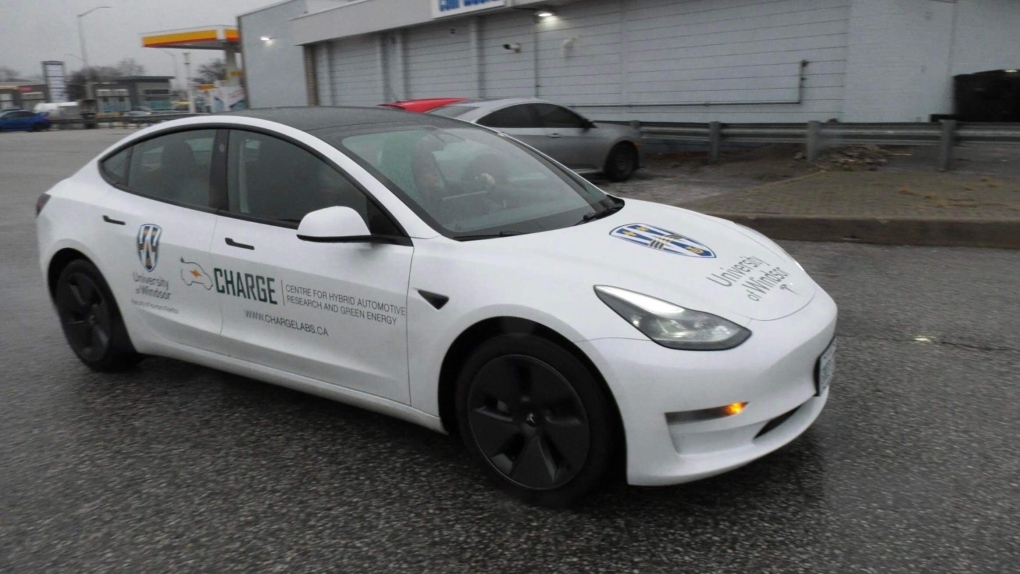University of Windsor data reveals how drivers use automated driving systems
Researchers at the University of Windsor are set to review data gathered over the last five months to assess how drivers use automations when behind the wheel.
It is part of a $319,000 study that involves a team of research subjects who drive a recently purchased Tesla Model 3 on Highway 401 from Windsor to Chatham and back.
“This is one of the first projects of this kind in Canada,” said Francesco Biondi, a professor of kinesiology. “We need to study how drivers use semi-automatic driving systems and understand the distraction potential of using these technologies.”
Biondi and engineering professor Balakumar Balasingam, are conducting a real-world study of advanced driver assistance systems. The researchers compare driver behaviour when the vehicle is in the manual driving mode and when it is in Tesla’s partially automated “autopilot” mode.
Biondi told CTV News Windsor, “We see some drivers getting a little frightened because they're used to the car driving pretty well in all honesty. But then as soon as something unpredictable, if something unusual starts happening, they become a little frightened.”
The Tesla is outfitted with a dashboard-mounted eye tracker that monitors pupil dilation, blink rates, and gaze to assess the driver’s alertness. Drivers wear other devices to monitor other physiological metrics such as heart rate.
 A University of Windsor CHARGE vehicle (Centre for Hybrid Automotive Research and Green Energy) is seen in Windsor, Ont. (Chris Campbell/CTV News Windsor) Researchers noticed when drivers use the autonomous features, they became more distracted, according to Biondi.
A University of Windsor CHARGE vehicle (Centre for Hybrid Automotive Research and Green Energy) is seen in Windsor, Ont. (Chris Campbell/CTV News Windsor) Researchers noticed when drivers use the autonomous features, they became more distracted, according to Biondi.
“They sort of kickback,” Biondi said. “Humans are lazy, so we tend to sort of like whatever opportunity we may have to sort of take advantage of it.”
He continued, “I feel for the motorist because they're stuck between a rock and a hard place. Because on the one hand whenever they go into the dealerships, or they look up online or they watch the ads on TV or on the internet, maybe they're not told directly, but they're sort of given the sense that these vehicles may be capable to do more than they're supposed to.”
Biondi believes more education is needed as autonomous vehicles become more commonplace.
The study’s findings will be shared so manufacturers can make improvements to driver monitoring systems. The researchers will also make recommendations to the MTO with the goal of improving driver training.
“The more advanced these vehicles become, the more that component, that factor becomes more important to help drivers better understand how to use this technology. What to do and more importantly, what not to do,” Biondi added.
CTVNews.ca Top Stories

'It could be catastrophic': Woman says natural supplement contained hidden painkiller drug
A Manitoba woman thought she found a miracle natural supplement, but said a hidden ingredient wreaked havoc on her health.
WATCH Video shows dramatic police takedown of carjacking suspects chased through parking lot north of Toronto
Police have released video footage of a dramatic takedown of a group of teens wanted in connection with an attempted carjacking in Markham earlier this month.
After hearing thousands of last words, this hospital chaplain has advice for the living
Hospital chaplain J.S. Park opens up about death, grief and hearing thousands of last words, and shares his advice for the living.
DEVELOPING G7 warns of new sanctions against Iran as world reacts to apparent Israeli drone attack
Group of Seven foreign ministers warned of new sanctions against Iran on Friday for its drone and missile attack on Israel, and urged both sides to avoid an escalation of the conflict.
WHO likely to issue wider alert on contaminated cough syrup
The World Health Organization is likely to issue a wider warning about contaminated Johnson and Johnson-made children's cough syrup found in Nigeria last week, it said in an email.
Advocacy groups speak out against domestic violence comments by Nova Scotia minister
Several Nova Scotia groups that assist women are speaking out against comments on domestic violence by Justice Minister Brad Johns, and at least one is calling for his dismissal.
A couple lost their wedding rings during the ceremony. Two strangers found a fitting solution
Every good wedding has to have one teensy, tiny crisis.
'It was all my savings': Ontario woman loses $15K to fake Walmart job scam
A woman who recently moved to Canada from India was searching for a job when she got caught in an online job scam and lost $15,000.
Families to receive Canada Child Benefit payment on Friday
More money will land in the pockets of some Canadian families on Friday for the latest Canada Child Benefit installment.































